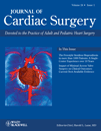Extraaortic Counterpulsation with a Latissimus Dorsi Flap: Hemodynamic Effects in a Heart Failure Model
Abstract
The aim of this study was to evaluate the hemodynamic effects of extraaortic counterpulsation with a latissimus dorsi (LD) neurovascular flap in a canine heart failure model. Five dogs (8-18 kg) had a left LD neurovascular muscle flap raised. The muscle was brought into the chest through the second interspace and wrapped around the aorta. Parameters studied were heart rate (HR), systolic pressure (SP), diastolic pressure (DP) pulmonary artery pressure (PAP), mixed venous oxygen saturation (MV02), and cardiac output (CO). Baseline measurements were obtained with the muscle nonstimulated and stimulated by a prototype burst stimulation. The only parameter that changed significantly with muscle stimulation was DP (55.8 ± 3.8 mmHg to 72.4 ± 4.8 mmHg, p < 0.05). Propranolol (3-4 mg/kg) and verapamil (2-3 mg) were given intravenously to induce heart failure. Mean blood pressure decreased from 64.12 ± 5.03 mmHg to 43.3 ± 9.28 mmHg (p < 0.05). Repeat measurements were obtained. With stimulation of the muscle flap there was an increase in DP from 36.8 ± 9.2 mmHg to 55.4 ± 19.3 mmHg (p < 0.05). Although CO increased from 8% to 18% in all animals (1.42 ± 0.33 L/mm to 1.58 ± 0.34 L/mm) this did not reach statistical significance. This data indicates that both DP and CO can be Improved by this method of cardiac assist in a heart failure model.




